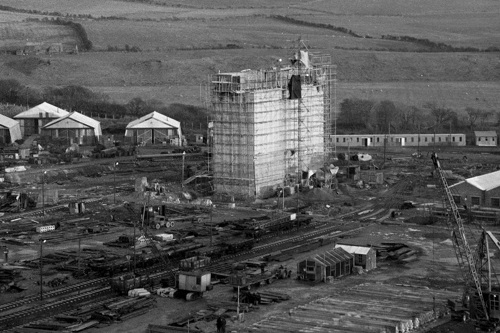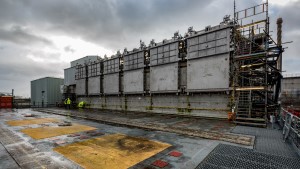Work has started to remove historic waste from one of Sellafield’s oldest storage facilities in another significant step forward at the Cumbrian site.
The start of landmark retrievals at the Pile Fuel Cladding Silo (PFCS) follows the Office for Nuclear Regulation’s (ONR) decision to grant permission to Sellafield Ltd, part of the ongoing strategy to reduce the long-term hazard and risk on the site.
 The Pile Fuel Cladding Silo under construction in 1951
The Pile Fuel Cladding Silo under construction in 1951Originally commissioned in the early 1950s, it is an ONR and a national priority to ensure the waste stored in this ageing silo is removed and placed into storage facilities that meet modern safety standards.
The PFCS contains around 3,200m³ (equivalent of approximately 30 double decker buses), of intermediate level waste (ILW), which was routinely tipped into the silo until 1964, with further occasional tipping work continuing until 1972.
Since then, the silo has been in a state of care and maintenance with the waste inventory remaining largely untouched.
This week’s start of active retrievals from the facility is the culmination of many years of work.
 The concrete structure is 29m long, 10m wide and 18m high and is divided into six tall compartments
The concrete structure is 29m long, 10m wide and 18m high and is divided into six tall compartmentsAlan Wylie, ONR’s Superintending Inspector, who leads the Sellafield project inspection team, said: “After a rigorous and detailed assessment of their safety case, we have granted permission for Sellafield Ltd to commence retrievals from the facility.
“We are satisfied that Sellafield Ltd’s safety case demonstrates that any risks will be suitably controlled and subject to robust surveillance and monitoring.
“We will continue a programme of regulatory oversight as the work progresses.
“The phased approach to the retrievals process that is well developed at other facilities on the site, will ensure that work is closely controlled and will only progress if it is safe to do so.”
Paul Dicks, ONR’s Director of Regulation – Sellafield, Decommissioning Fuel and Waste, said: “I am immensely proud of the efforts of the ONR team, who have contributed and helped us get to the point of being able to grant permission for retrievals to commence from this facility.
“Ensuring that legacy waste is safely removed from the PFCS and placed into storage facilities that meet modern safety standards is a priority for ONR, so I’m pleased to see that work has now started to remove waste from this ageing facility.”
 All six silo doors in situ on the side of the silo
All six silo doors in situ on the side of the siloThe silo is internally divided into six compartments. Waste contained in the PFCS consists largely of fuel cladding and experimental residues that were tipped into the compartments through access points in a roof tunnel.
Work to remove the waste from the compartments is estimated to take around 20 years to complete.
Once waste is removed it will be transferred and stored in modern facilities on site, pending long term disposal in a Geological Disposal Facility.